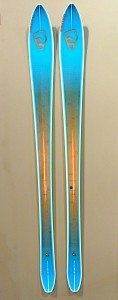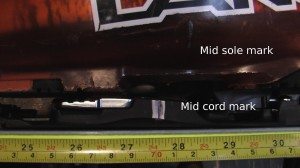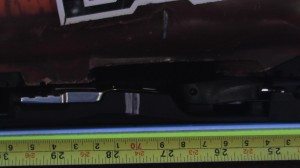
First Impressions: Salomon BBR, 186cm
Ski dimensions (mm): 147-88-102 (176 cm)
Radius: 11.5(166cm)/12.5(176cm)/13.5(186cm)
Available length of skis: 166cm, 176cm, 186cm
Boots / Bindings: Lange RX 130 / Salomon demo bindings
Mount Location: began on the line, but read the review….
Test Location: Taos Ski Valley
I have to admit that I was pretty excited to try out the Salomon BBR. It reminded me of an old, old 7’6” Degroot and Mason surf board I had back in the day with a really wide nose that tapered down to a super pin tail. It was an interesting ride.
The BBR finally came in last week in a 186. Salomon is touting the BBR as a quiver-of-one ski, and claiming that, “with a ski like the BBR, we really challenge conventional wisdom regarding shape, and we believe that this could be the shape of the future for many all terrain skiers. The super fat tip floats like a Rocker, and the sidecut and the patented shape allows it to rip on the groomed trails.” (Salomon’s Mike Aicher, quoted here).
Well alright, let’s go see.
I took the BBRs out for a ride on Friday, January 14th, where conditions were prime for testing the BBRs groomer performance. As I got off the chair at the top of 1 and skied toward chair 2, I was pleasantly surprised by how easy the BBR initiated a turn. The pitch from 1 to 2 is relatively flat, so it’s hard to muster much speed to really pass judgment. But it’s enough to get an idea. Making silky smooth, short turns all the way to chair 2, I was eager to put the BBRs on some real terrain. On to Reforma….
A steep bump run with a double fall line, Reforma is an excellent testing ground for skis. Since it falls directly under lift 2, gapers tend to steer clear of Reforma, so it usually has some of the best formed bumps on the mountain. The first few turns were a little weird as I negotiated some of the sharks. The skis hooked up quickly and wanted to come across the fall line more than I like, and had a burst of power out of the turn that took me by surprise. All the way down Reforma I found myself hating this ski. I tried to keep an open mind as I hit the top of Bonanza and pushed it to top speed. Not a good idea. The tendency to hookup and jet out of an unfinished turn had me scrubbing speed. Back to slower, shorter turns. I got back on the lift trying to understand why the BBR doesn’t like bumps, high speed, or long turns.
That run reminded me of the time I had mounted my Dynastar Legend Pro Rider too far forward. The ski loved to initiate a turn but hated to finish. So after some thought, I decided that when I got to the top of the lift I would move the binding back a centimeter. I did, then began to make my way over to Longhorn, which had just opened the day before. All the way down Bambi the BBR was responding beautifully – not just to short radius turns, but to medium and long radius turns, too. It became far more predictable and easy. It should be noted, however, that the BBR does not like tongue pressure. So for those skiers who really like leaning into the tongue of their boots, beware: this ski prefers an upright stance. I found that by standing “cuff neutral,” the ski performs well and requires a lot less work.
Into Longhorn! The coverage is excellent for what little new snow we have had – just watch out for the rock band at the bottom of the first pitch. The BBR is really making it easy, almost effortless, in the softer conditions. With the binding in its new position I was able to choose the turn shape I wanted rather than have the ski decide for me. In the tricky flat section before the second pitch, I was able to navigate a variety of bump shapes masterfully. One thing that became a bit distracting was the constant banging of the tips. Every turn (well, maybe not every single turn…) it seemed that the downhill ski would deflect and collide with the other. This didn’t make the skiing any less easy, just a little unnerving. I don’t know if it’s the side-cut, the wide tips, the rocker or a combination of the three that is to blame for this phenomena. It seems safe, for now, to blame the combination, at least till I get out on this ski again for further testing – hopefully in some softer conditions….
BBR Day 2:
“Another day in paradise,” said the guy sitting next to me. I looked around and had to agree. It is 9:30 and the sun is shining brightly with a crisp chill on the mountain. I am excited to play with the binding position on the BBR. My experience the other day has definitely peaked my curiosity, and I begin again with the bindings set 1 centimeter back of recommended.
I decide Powderhorn will be the start of today’s experimentation. Freshly groomed, with plenty of pitch to get some real speed, I begin my descent. First some short turns, getting longer as I gain speed. The ski is performing as I expect. Short turns are smooth and quick, but as the speed increases and the turns get longer, stability becomes an issue. I start scrubbing speed as I approach the knoll above the last pitch and set up for Porcy corner. Porcupine corner is a sharp, flat turn to the left that can be really fun or really scary. Many skiers have misjudged this turn and wound up careening off into the trees below. So I’m a little concerned about how the BBR will handle the turn at the speeds I prefer. I set up for the corner as I normally would, but…I keep my speed in check, not ready to trust the ski fully just yet. I finish the turn without a problem and ski back to the lift.
Back at the top of 1, I set the binding back another centimeter and run Porcupine again. Stability improved which bolstered my confidence and I begin to push the envelope. Long, high-speed turns over the knoll and around the corner with no worries.
Now I’m thinking its time for a bump run. The conditions are firm and the thought of skiing bumps is not very appealing. I decide to ski Al’s Run for the length and consistent pitch. With the bindings 2 cms back, the ski is fairly predictable and the tail finishes the turn smoothly. I ski down to the top of the second pitch and stop to move the bindings back to factory position. As I expected, the ski became hooky and unpredictable. The tips were deflecting and I had a harder time keeping my line.
With my suspicions confirmed, I go to the backside (chair 7) to ski Totemoff, a favorite of many Taos tourists for its rolling terrain. The run is wide and the pitch forgiving. The sun shines nearly all day on this part of the mountain, and it is especially bright and warm this morning. Then I have an eye opening experience. While cruising fast and laying down some big, long carves, I look down at the skis. With the sun at a perfect angle, I can see sunlight between the edge of the ski and the snow: a glowing, yellow beam extending from the toe piece all the way to the contact point where the tip rocker starts. I’m thinking, How in the hell does a ski turn when half of it is off the snow? Ok, so now you’re probably thinking, “This guy is a tail gunner and doesn’t know how to ski.” Not true. It seems to me that the combination of the huge shovel and tip rocker is creating a vibration through the forebody of the ski at such a frequency that I can’t tell when the ski is on or off the snow….
By now it’s almost time to go to work. At the top of 7 I’m thinking, Let’s take it a step further, and I move the binding back another centimeter. That makes it 3 centimeters back of mid cord. I start down Honeysuckle on a high speed cruise to Baby Bear > Winkelried and Rubezahl. The whole way I am more than pleased with the performance of the BBR. Much more stability at speed and silky smooth. This is the kind of ski I am used to.
Back at the shop I start doing more investigative work. With tape measure in hand, I want to find out the actual measurements of this ski. I put the BBR on the bench, tie the brakes up, and clamp the skis together base to base. I then measure from contact point to contact point. The actual running length of the ski is 140 centimeters – pretty damn short, like most rockered skis. I also find that (again, like many rockered skis) the bindings are mounted so that the boot sole center is on the mid cord of the ski.
This image shows the mid sole mark on the boot, the mid cord mark of the ski, and the distance from the contact point measured from the front of the ski.
The following image shows the same as above, but measured from the tail of the ski. Notice that the mid cord mark sits very nearly at 70cm.
On the mountain, I’d been using the increments on the binding to determine how far back on the ski I had been set. According to the tape it looks more like 2 to 2.5 cm rather than the 3cm I mentioned earlier.
It makes sense now that the ski was hooky at the beginning of the turn and finished poorly. With the bindings set so that the boot center is on the mid cord, there is much more emphasis on the tip of the ski and too much tail to really finish a turn. The further back the binding, the smoother, more predictable the ride became. I think that this ski could be everything Salomon would like it to be if a binding like the Marker Schizo is used. The Schizo would allow the skier to move the binding fore and aft according to personal preference, making the ski really versatile.
I think the BBR is a good first attempt at building the “one ski quiver.” The general population of skiers will enjoy skiing the BBR, but it lacks a few characteristics that the expert / aggressive skier wants; namely, stability at speed and predictability in bumps and steep terrain (though this can be mitigated to some degree by mounting back 2 – 2.5cms. I find myself wondering why the mount point is so far forward in the first place, not just on the BBR but on any rocker with the exception of park/pipe skis….
If it were up to me, however, I would reduce the amount of rocker, narrow the tip by 5 to 10 mm, extend the sidecut further up the tip – thereby lengthening the radius to maybe 16 meters. But that’s just me.
I’m still anxious to test this ski in some deeper stuff, and I’ll report back as soon as I do.



I am intriqued by the comments about the center of the ski. It raises a couple of questions. First, was Charlie on a pair of final preduction skis or was he on a pre-production test model? Would Salomon have made an adjustment on the location of the “mid-boot” mark as a result of test feedback or do we need to take it into consideration when purchasing them. The reasom I am asking is that I am leaning toward the 7.9 BBR as an all round mountain ski and am wondering if I need to get the ski set up withe mid boot set back 2 cm. Any advise/suggestion?
Thanks
Al
I told our local sales rep about my findings and I know the comments went back to Salomon corporate. whether they made any changes to the mounting position on the ski is doubtful. I would recommend that either you demo the ski with the binding set at different positions on the ski or buy a Marker schizo binding. The schizo can be moved back and forth on the ski about 3cm in each direction.
I just demo’d these skis and used them at Crystal Mtn, WA in a variety of conditions– groomer, hard pack, ice, a stash or two with 4″ of soft snow. I was on a variety of terrain– wide open cruisers, moguls, steeps. I did not have deep pow to test them in. I am 5’8″, 150, expert. I used the 176. I disagree with every negative the reviewer mentioned. I do not know where they were mounted — wherever the Salomon demo rep chose. WHAT I DO KNOW is that these skis were great in every combination of speed, terrain, and surface condition. Not the ideal mogul ski, but much better than other powder skis. They felt rock solid, smooth, steady, responsive, stable. Edge hold was excellent, at mach speed on my second run, I had no worries at all. I am dying to know how they float in powder. If they are good, I am definitely getting a pair.
@ Jon Lauer,
I have been very interested in Demoing these skiis. I, too am in the Seattle area. Where were you able to find a pair to demo?
I had much the same experience as Jon did when I tested the 176. I am wondering if the binding position is a greater sensitivity on the longer 186? It makes sense to me that it would.
I was able to try the ski in boot top powder and the flotation seemed excellent. I love the short turning radius but was pleasantly surprised at the stability in large fast GS turns. I did not experience the “constant banging of the tips”.
Based on a day long demo, during which I encountered just about every condition, I went out and bought a pair. My only regret is that I did not put a pair of Marker Schizo which would let me tinker with the boot position.
Mountain to Sound in West Seattle has a couple of these in their demo line up
Sorry for the OT question; will you guys be putting out a review of the 11/12 Rocker 2?
Probably not the 11/12, but we will be reviewing the 12/13 – and soon….
Been out in Lake Louise for 6 days and had a chance to Demo a few Ski’s.
My kids have been pushing me to try out the BBR Salomon (always have been partial to Volki) so I did… Need to say….I had a wonderful ride!!
Had them for two days on groomers, piste and off piste in power conditions, GREAT TIME. Ski totally out preformed my expectations by miles. The skis did everything I wanted them to do and THEN SOME. Needed to get use to the look but once I did that and concentrated on the actual skiing to was a fantastic experience and effortless.
I would totally suggest that everyone should try them out!!
Going to Ski tomorrow at Kicking Horse, BC will definitely be bring the BBR Salomon.
Interesting. I know 1st hand from having a pair of skis mounted wrong what a huge difference 2.5cm makes. That’s a full inch in old money. I just bought a pair for ridiculously cheap on clearance and am leaning toward having the shop mount them 1-1.5cm back of center. In the old days ROT was boot toe at cord center for GS, 1.5 forward for slalom and 1,5 back for DH. This new V shape sounds an awful lot like the Solomon Y shaped skies circa turn of the millennium.
My thank you to the reviewer, I read his review after my first day on these skis, made the adjustments as he described, and the performance improvements were remarkably noticeable. My experience with the position adjustments were very similar in variable snow conditions, as he explained. I think he is right on!
I LOVE these skiis. I love that they kick me out of a turn. I love that they handle powder or ice consistently.